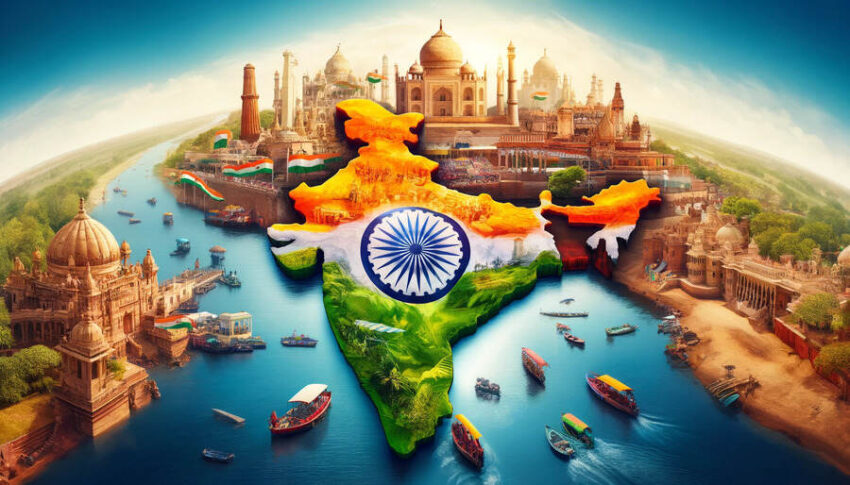Monday, April 8, 2024

India & China reshape global tourism, fueling growth with their booming outbound markets as the world adapts to welcome these pivotal travelers.
In a pivotal shift poised to redefine global demographics, India’s population is on track to surpass China’s by mid-year, with projections indicating a rise to 1.4286 billion against China’s 1.4257 billion. This transition not only marks India’s ascent as the world’s most populous country but also underscores the burgeoning influence of Indian and Chinese tourists in the global travel industry. As these two nations ascend the global stage, their outbound tourism sectors are igniting a boom across the travel industry, with destinations worldwide vying to attract this vast and growing consumer base through incentives like visa-free arrivals and enhanced travel experiences.
The surge in outbound tourism from India and China is reshaping the landscape of global tourism, compelling countries to tailor their offerings to the preferences and expectations of these travelers. This shift is driven by the expanding middle classes in both countries, equipped with the disposable income and the desire to explore international destinations. Recognizing the immense potential of the Indian and Chinese markets, nations around the globe are adapting their strategies to welcome these travelers, whose preferences are now pivotal in shaping the future trends and economic prospects of the global travel industry.

In a significant move poised to redefine its economic landscape, China has earmarked substantial funds towards rejuvenating its tourism sector in 2023. Predictions suggest an impressive escalation in tourism revenue, poised to hit 5.2 trillion yuan (US$724.8 billion), a resurgence to 91% of the pre-pandemic levels observed in 2019. This strategic infusion of capital underscores tourism’s pivotal role in catalyzing economic recovery and expansion, further highlighting its influence on employment and overall economic vitality.
A noteworthy anticipation by the United Nations Tourism casts the spotlight on an expected uptick in both inbound and outbound tourism for China in 2024. This optimistic projection is anchored on the ease of visa regulations and enhancements in air travel capacity. In an unprecedented gesture of goodwill and strategic tourism promotion, China has initiated a year-long visa-free travel policy for nationals from France, Germany, Italy, the Netherlands, Spain, and Malaysia, valid through to 30 November 2024.
China’s forward-looking investment in its tourism infrastructure in 2024 is a testament to the sector’s robust growth and the country’s concerted efforts to attract a global traveler base. The resurgence in travel activity, especially highlighted by the surge during the Chinese New Year holidays in 2024, has yielded impressive domestic tourism revenue figures, amounting to roughly RMB 632.7 billion (approximately $87 billion). This marks a notable rise from the preceding years, fueled by eased visa policies, expanded air travel capacity, and collaborative marketing initiatives aimed at wooing Chinese tourists.
In a strategic move to invigorate tourism, China has set ambitious visitation goals for 2024, targeting significant tourist influxes to popular destinations such as Thailand and Indonesia. These initiatives are part of a broader strategy to leverage the escalating demand for travel and leisure, both domestically and internationally.
The Lunar New Year holidays in 2024 witnessed a staggering 47.3% year-on-year increase in tourism revenues, catapulting figures beyond the pre-Covid benchmarks of 2019. The festive period alone generated approximately 632.7 billion yuan ($87.96 billion) in domestic tourism spending, surpassing previous records and indicating a recovery trajectory that exceeds pre-pandemic levels by 7.7%. Furthermore, the anticipated total revenue from domestic tourism in 2023 is set to exceed RMB 4 trillion (about US$580 billion), reflecting a 96% growth. This surge is attributed to relaxed travel restrictions, an increase in disposable incomes, and the burgeoning appeal of domestic travel destinations.
Through these strategic investments and policy adjustments, China is not only paving the way for a robust tourism sector but also positioning itself as a leading destination in the global travel and leisure industry, signaling a promising future for its economic and cultural landscape.

China’s strategic investments within its airline sector underscore a broad and ambitious plan to fortify its position as a global aviation powerhouse. These investments, spanning capital injections, substantial aircraft acquisitions, and enhancements in aviation services, reflect a multifaceted approach to nurturing the industry’s growth and resilience.
A prime illustration of these efforts is China Southern Airlines’ significant capital contribution of US$1.69 billion (RMB 11.2 billion) to Sichuan Airlines. This move, structured in three distinct installments, aims at bolstering Sichuan Airlines’ working capital while mitigating financial security risks. Such strategic alliances underscore a commitment to stability and growth within China’s aviation landscape.
In a monumental leap forward, July 2022 saw four major Chinese airlines place a collective order for 292 Airbus aircraft, amounting to US$37.3 billion (RMB 249.3 billion). Dubbed the “biggest ever single-day jet deal,” this acquisition underscores China’s ascending trajectory in the global aviation market and its ambition to meet burgeoning air travel demand.
Boeing’s projection further illuminates the expansive horizon for China’s aviation industry, estimating a need for 8,560 new commercial airplanes through 2042. This forecast, propelled by China’s economic momentum and a rising penchant for domestic air travel, anticipates a staggering $675 billion worth of aviation services demand. This encompasses maintenance, repair operations, training, and the provision of spare parts, highlighting the comprehensive growth potential of China’s aviation sector.
The International Air Transport Association (IATA) report sheds light on the significant growth in domestic demand within China, particularly emphasized by the Lunar New Year travel period. This surge is marked by an impressive uptick in air traffic, with specific figures highlighting:
China’s aviation sector is on a clear upward trajectory, marked by strategic investments across the board. From capital contributions that strengthen airline operations to record-setting aircraft orders and forecasts predicting a surge in commercial airplane demand, China is laying down the foundation for a future where it remains a central figure in global aviation. These initiatives not only signify China’s ambition to expand its aviation footprint but also highlight its role in shaping the future of global air travel and commerce.

China’s hotel industry is currently undergoing a remarkable phase of expansion and prosperity, primarily fueled by a growing middle class characterized by rising travel aspirations and increased disposable income. Projections indicate that by 2028, the Chinese hotel market is poised to reach a staggering US$ 166.02 billion, propelled by a robust Compound Annual Growth Rate (CAGR) of 8.86% from 2022 to 2030. This upward trajectory underscores the industry’s vibrant potential and the burgeoning demand for hospitality services across the country.
The segmentation of the Chinese hotel market into high-end, mid-end, and budget hotels showcases the industry’s versatility in catering to a broad spectrum of travelers. Mid-range hotels, in particular, are anticipated to dominate the market in the forthcoming years. This segment appeals to a diverse clientele, including business travelers, budget-conscious tourists, and leisure travelers, by offering a balanced mix of affordability and quality. Moreover, the market distinction between hotel chains and independent hotels highlights a clear preference among travelers for hotel chains, attributable to their established brand recognition and consistency in service quality.
A comprehensive report on China’s hospitality industry forecasts an optimistic growth trajectory, with the market size expected to burgeon from USD 86.66 billion in 2024 to USD 128.04 billion by 2029. This expansion reflects a steady CAGR of 8.12% during the forecast period, driven by an increase in hotel projects and room availability. Specifically, the first quarter of 2022 witnessed the addition of 3,711 new hotel projects and 704,101 rooms, underscoring the rapid pace of development within the sector.
The Chinese government’s strategic policies, including the Belt and Road Initiative and the establishment of special economic zones, have significantly contributed to the hotel market’s growth. These initiatives have not only enhanced China’s appeal as a travel destination but have also attracted foreign investment, particularly in major urban centers like Beijing and Shanghai. Despite the intense competition and regulatory challenges, second-tier and remote cities continue to attract foreign capital, driven by their potential for growth and the allure of untapped markets.
Chinese companies have made noteworthy strides in the global hotel industry, acquiring substantial stakes in Western hotel chains. For instance, Jin Jiang’s 13% ownership in France-based Accor and Huazhu Hotels Group’s acquisition of Germany-based Deutsche Hospitality highlight the international ambitions of Chinese hoteliers. Although recent years have seen a recalibration of investment strategies due to geopolitical and regulatory shifts, Chinese firms continue to actively participate in the global hospitality market.
The trajectory of China’s hotel industry is marked by significant growth, driven by demographic shifts, strategic government initiatives, and a keen interest from both domestic and international investors. Despite facing challenges, the sector remains poised for a bright future, with a diverse range of hotels catering to the varied needs of travelers and a strategic focus on expanding China’s influence in the global hospitality landscape.

China’s strategic foray into the travel technology industry is reshaping the landscape of travel, with a significant push towards digital integration and online platforms. The online travel sector, buoyed by the ubiquity of smartphones, is witnessing unparalleled growth, with mobile and tablet transactions leading the charge. This digital shift is not just changing how travel services are accessed and booked but is also enhancing the overall travel experience for consumers.
The online travel market in China is on an impressive trajectory, with forecasts projecting a reach of US$1.56 trillion by 2030. This growth, characterized by a Compound Annual Growth Rate (CAGR) of 12.99% from 2023 to 2030, underscores China’s dominant position in the global online travel industry. Key drivers of this growth include the expanding middle class, increased internet and mobile penetration, and proactive government initiatives, which collectively are setting new benchmarks in travel planning and bookings.
Trip.com’s reports offer a tangible glimpse into the burgeoning success of China’s online travel sector. A remarkable four-digit growth in visitor numbers compared to the same period in 2022 indicates a swift rebound to more than 60% of pre-pandemic levels. Furthermore, Malaysia and Germany emerge as leading contributors to inbound tourism, with notable spikes in interest and bookings highlighting a revived global interest in traveling to China.
The recovery extends to long-haul inbound travel, with European bookings to China not only surpassing pre-pandemic levels but also recording a staggering increase of 663.0% compared to 2022 and a 28.9% growth over 2019. This resurgence signals a robust recovery and a growing appetite for Chinese travel experiences among international travelers.
China’s travel technology landscape is dotted with innovators and industry leaders who are defining the future of travel. Prominent players include:
The potential of China’s inbound tourism is immense, with projections suggesting that aligning it to the international median of 1.5% of GDP could unlock over RMB 1.3 trillion in growth. This opportunity underscores the strategic importance of the travel technology sector in not just enhancing travel experiences but also in contributing significantly to the country’s economic growth.
China’s investment in the travel technology industry marks a significant pivot towards digitalization, underscoring the country’s commitment to revolutionizing the travel experience. Through strategic investments, innovative platforms, and a focus on digital integration, China is not just navigating the future of travel but is setting new standards for the global travel industry. As the sector continues to evolve, the contributions of leading travel technology companies will undoubtedly play a pivotal role in shaping a more connected and digitally savvy travel ecosystem.

The Indian government has underscored its commitment to bolstering the tourism sector with a significant budget allocation of ₹2,400 crore for the fiscal year 2023-2024. This marks an 18.24% increase from the previous budget, spotlighting the sector’s pivotal role in India’s economic framework. Anticipated to contribute 9.9% to the nation’s GDP by 2030, this investment strategy is tailored to encompass key developmental areas: infrastructure enhancement, promotional endeavors, and the upliftment of domestic travel destinations.
Central to this financial strategy is the allocation of ₹1,644 crore towards infrastructure development and ₹421.50 crore dedicated to the promotion and publicity of India’s rich tapestry of travel destinations. An additional ₹75 crore has been earmarked for domestic promotion, alongside a ₹250 crore investment in the PRASAD scheme, aimed at rejuvenating pilgrimage sites across the country.
In a bid to further diversify India’s tourism offerings, the government plans to develop 50 new travel destinations under the ‘Swadesh Darshan’ initiative, focusing on connectivity, tourist security, and natural beauty. The innovative concept of Unity Malls in State Capitals or prominent tourist centers is set to promote the local culture and products of each state, enhancing the visibility and appeal of India’s diverse cultural heritage.
The concerted focus on tourism is poised to generate substantial employment opportunities, particularly for the youth, in various sectors including hospitality, hotels, airlines, and food and beverages. By fostering infrastructure development and promoting local artists and businesses, the government aims to not only elevate the tourism sector but also to stimulate youth entrepreneurship.
With the tourism sector’s revenue projected to reach over $59 billion by 2028 and Foreign Tourist Arrivals expected to hit 30.5 million by the same year, India’s strategic investments in tourism are aimed at catalyzing job creation, with an estimated 140 million jobs anticipated by 2030. The government envisions positioning India as a premier global travel destination by 2047, celebrating the country’s centennial with a robust and vibrant tourism industry.
The World Travel & Tourism Council (WTTC) forecasts the sector to inject INR 16.5 trillion into the Indian economy, with over 1.6 million jobs expected to be created within the year, nearly recuperating the employment shortfall induced by the COVID-19 pandemic. International visitor spending is set to exceed INR 2 trillion, with domestic visitor spending anticipated to surpass INR 12.6 trillion.
Moreover, the burgeoning wellness tourism market in India is projected to expand from USD 19.43 billion in 2024 to USD 26.55 billion by 2029, growing at a CAGR of 6.45%. This growth trajectory underscores the burgeoning appeal of wellness tourism, aligning with global trends towards health and wellness.
India’s strategic investments and visionary initiatives in the tourism sector herald a renaissance of growth and development. By enhancing infrastructure, promoting cultural heritage, and fostering an inclusive economic impact, the government is laying the groundwork for a sustainable and dynamic tourism industry. With the anticipated economic contributions and job creation, India is steadily advancing towards its goal of becoming a global tourism powerhouse by 2047, embodying a rich tapestry of cultural diversity, heritage, and natural beauty.

India’s aviation sector is witnessing an unprecedented surge in growth and development, evidenced by the dramatic increase in the number of airports from 74 in 2013-2014 to an anticipated 220 by 2024-2025. This expansion reflects a deep-rooted commitment to enhancing the country’s aviation infrastructure, accommodating the burgeoning demand for air travel. With the aviation industry projected to contribute up to $1 trillion annually to the economy by 2043, India’s strategic investments are setting the stage for a transformative impact on the national and global aviation landscape. The addition of 470 aircraft to an already impressive order of 800 underscores a robust investment pipeline that promises to bolster the country’s air transport capabilities significantly.
The UDAN (Ude Desh ka Aam Naagrik) scheme, launched in 2016 under the National Civil Aviation Policy (NCAP), epitomizes India’s vision of making air travel accessible to the wider populace. By enhancing connectivity to underserved and unserved routes, UDAN is a cornerstone initiative driving tourism, trade, and economic empowerment across various regions. With 75 airports operationalized under the scheme as of October 2023, UDAN’s phased implementation has been instrumental in expanding India’s aviation network, marking a pivotal shift towards inclusive growth and regional development.
From the commissioning of 36 new airports and 128 flight routes in UDAN 1.0 to the introduction of helicopter and seaplane routes in subsequent phases, each iteration of UDAN has broadened the scope of India’s aviation reach. UDAN 4.0 and 4.1, in particular, have focused on enhancing connectivity to remote islands and underserved areas, further solidifying the scheme’s role in knitting a more connected and accessible India. The scheme’s integration with key governmental initiatives underscores its multifaceted impact, contributing to the broader vision of Digital India, Make in India, and enhancing e-governance and digital connectivity.
The aviation sector’s anticipated economic contribution, along with the successful implementation of the UDAN scheme, signals a new era of prosperity and connectivity for India. The scheme not only fosters regional development but also catalyzes demand for a diverse range of aircraft, supporting the dynamic growth of the aviation industry.
The International Air Transport Association (IATA) paints a promising picture for India’s aviation sector, with profits expected to hit $25.7 billion and operating profits forecasted to reach $49.3 billion in 2024. This optimistic outlook, coupled with projected revenue growth of 7.6% to $964 billion, reflects the robust health and upward trajectory of India’s airline industry.
India’s strategic investments in the airline and aviation industry, highlighted by the expansion of its airport infrastructure and the visionary UDAN scheme, are charting a new course for national and global aviation. These initiatives, backed by the positive economic forecasts from IATA, position India as a burgeoning aviation hub poised for significant growth. As the country continues to invest in and expand its aviation capabilities, the promise of enhanced connectivity, economic prosperity, and regional empowerment stands as a testament to India’s skyward journey.

India’s hospitality sector is on a trajectory of rapid growth, with mid-size and upscale hotel companies at the forefront of this expansion. A notable investment of Rs 3,500 crore, as reported by Noesis Capital Advisors, is set to introduce over 5,000 new rooms into the market, alongside approximately 25,000 job opportunities. This investment not only underscores the industry’s capacity expansion ambitions but also highlights the sector’s significant role as an economic catalyst.
The sector’s growth is intricately linked with the surge in religious tourism, with hotel companies increasingly focusing on expanding their presence in key religious destinations such as Haridwar, Amritsar, Mathura, Dwarka, Varanasi, and Sikar in Rajasthan. This strategic alignment with the rising tide of devotees traveling to religious sites presents a unique opportunity for the hospitality industry to cater to a niche yet expanding market segment.
Investments in India’s hospitality industry are anticipated to exceed $2.3 billion in the next two to five years. This influx, earmarked for the development of new hotels and the refurbishment of existing ones, is poised to bolster the industry’s growth, offering diverse opportunities for investors and stakeholders. The envisioned expansion not only promises to enhance the sector’s capacity but also to diversify the hospitality offerings available to travelers and devotees.
For investors eyeing the hotel industry, prominent companies such as Indian Hotels Co, East India Hotels, Chalet Hotels, Lemon Tree Hotels, and Mahindra Holidays & Resorts India Ltd represent prime avenues for growth and investment. These entities stand out for their commitment to excellence in hospitality services and their strategic focus on value creation for investors, marking them as attractive options for those looking to tap into India’s burgeoning hotel industry.
The HVS ANAROCK report highlights remarkable achievements in the industry, with Mumbai setting a precedent by surpassing the 80% occupancy level. Similarly, Kolkata and Ahmedabad have exceeded the 75% occupancy mark, showcasing the robust demand driving the market. Additionally, Hyderabad and Kochi have witnessed a commendable year-on-year increase of over 30% in average rates, indicating a strong pricing power and market resilience.
According to Renub Research, the India Hotel Market is projected to reach a staggering US$ 47.50 billion by 2030, with a Compound Annual Growth Rate (CAGR) of 12.50% from 2022 to 2030. This forecast underscores the dynamic growth potential of India’s hotel industry, positioning it as a key player in the global hospitality arena.
India’s hotel industry is poised for unprecedented growth, fueled by strategic investments, the booming demand for religious tourism, and a focus on enhancing capacity and service quality. As the industry navigates through a period of expansion and diversification, the pathway is set for creating substantial economic value, generating employment, and offering lucrative opportunities for investors. The sector’s robust growth projections affirm its vital role in India’s economic landscape, heralding a new era of prosperity and global prominence in the hospitality domain.
The travel technology landscape in India is vibrant and dynamic, with several key players driving innovation and enhancing the travel experience for millions. These companies have not only revolutionized the way travel bookings are made but have also significantly contributed to the growth of the tourism sector in the country. Here’s a closer look at the top 5 travel technology pioneers in India:
EaseMyTrip stands out for its user-friendly platform and comprehensive travel solutions. Known for offering competitive airfares, hotel bookings, and holiday packages without convenience fees, EaseMyTrip has carved a niche for itself in the travel industry. Its commitment to providing value-driven services has made it a preferred choice among travelers seeking hassle-free travel planning.
A trailblazer in the Indian travel technology sector, MakeMyTrip has been at the forefront of transforming how Indians travel. Offering a wide array of travel services, including flight bookings, hotel reservations, holiday packages, and more, MakeMyTrip is synonymous with convenience and reliability. Its innovative use of technology to enhance customer experience has set industry standards.
Yatra has firmly established itself as a leading travel technology company in India, offering diverse travel services across its platform. From domestic and international flights to hotels and holiday packages, Yatra provides a seamless booking experience. It is known for its excellent customer service and competitive pricing, making it a go-to platform for many travelers.
Goibibo is a key player in India’s travel technology landscape, renowned for its intuitive user interface and wide range of travel products. It specializes in providing affordable travel options, including flights, hotels, and bus bookings, making travel accessible to a broader audience. Goibibo’s continuous innovation in technology has enhanced its popularity among the younger demographic.
Cleartrip rounds out the top five with its clean, simple, and efficient platform. It offers a hassle-free booking experience for flights, hotels, and trains, among other travel services. Known for its straightforward approach to travel planning, Cleartrip emphasizes transparency and ease of use, appealing to travelers who value simplicity and reliability in their travel arrangements.
These top 5 travel technology companies are revolutionizing the travel and tourism industry in India, making it easier and more accessible for people to explore the world. Their innovative platforms, emphasis on customer satisfaction, and commitment to providing value have set them apart as leaders in the field. As the travel industry continues to evolve, these companies are poised to play a pivotal role in shaping its future, driving growth, and enhancing the travel experience for millions of users.

India is on the cusp of a transformative era, marked by substantial investments in AI infrastructure and startups, projected to reach US$1.2 billion. The burgeoning AI market, expected to soar to US$17 billion by 2027, is poised to revolutionize various sectors, including travel technology. This investment signifies a major leap towards harnessing AI’s potential to drive innovation, sustainability, and enhanced customer experiences within the travel industry.
The Indian travel technology sector is witnessing a significant surge in investment, with an anticipated growth rate of 14% in 2024. The focus is sharply on integrating Environmental, Social, and Governance (ESG) initiatives, underpinned by the pivotal role of technology in fostering sustainable travel practices. A report by Amadeus underscores the industry’s commitment to ESG, with 58% of Indian travel companies set to augment their ESG investments in the coming year. The overwhelming consensus (91%) among industry stakeholders is that technology is indispensable in achieving sustainability goals, particularly in initiatives aimed at carbon footprint reduction and atmospheric CO2 removal, which 34% of respondents believe to hold the highest potential impact.
The optimism towards achieving a sustainable future in travel is tangible, with 92% of industry professionals either having a concrete strategy in place or planning to adopt one in 2024 to meet sustainability objectives. Despite the enthusiasm, the path to sustainability is fraught with challenges, including financial constraints, technological limitations, and the need for executive support. Yet, the resolve remains strong within the global travel industry, with 79% of ESG decision-makers confident in the industry’s capacity to reach net zero emissions.
Easemytrip exemplifies the potential for success in integrating technology and sustainability within the travel industry. The company’s recent financial performance, with a 9.6% increase in consolidated net profit to INR 456 million ($5.5 million) and an 18% year-on-year growth in operating revenue to INR 1.61 billion ($19.3 million) as of December 2023, highlights the robust demand and the efficacy of leveraging technology to enhance service offerings and operational efficiency. This success story not only reflects the financial viability of sustainable practices but also underscores the significant role of technological innovation in shaping the future of travel.
India’s strategic focus on AI and travel technology investment marks a pivotal shift towards a more sustainable, efficient, and customer-centric travel industry. As the country harnesses the power of AI and technology, it sets a precedent for innovation, aiming to redefine the travel experience while addressing critical environmental challenges. The collective drive towards sustainability, backed by technological advancements and strategic investments, signifies a promising horizon for the Indian travel technology sector, aiming to achieve global leadership in creating a more sustainable and innovative travel ecosystem.
As we navigate through a transformative era in global tourism, the emergent roles of India and China stand as pivotal forces within the international travel landscape. The impending demographic milestone, wherein India’s population is set to surpass that of China, marks a significant juncture, positioning India as the world’s most populous nation. This demographic shift, coupled with the economic vigor of both countries, is profoundly influencing the global tourism sector. Nations across the globe are keenly adapting their tourism strategies, offering tailored experiences and easing travel restrictions to attract the burgeoning middle classes from India and China, recognizing their crucial influence on the future of travel and tourism.
Throughout this article, we’ve explored the multifaceted contributions of India and China to the global tourism narrative, spanning investment in the tourism sector, airline industry, hotel industry, travel technology, and the burgeoning field of AI. The world is increasingly attuned to the preferences and economic power of travelers from these nations, driving a global shift towards more inclusive, technologically advanced, and sustainable travel offerings. The engagement of countries in attracting these markets underscores a universal recognition of their potential to redefine the economics and cultural dimensions of global tourism. As we look towards the horizon, the influence of India and China on global tourism is poised not only for growth but for a redefinition of travel norms and practices, promising a new era where India Tourism, China Tourism, Investment in Tourism Sector, India Airline Industry, China Airlines Industry, India Aviation Industry, China Aviation Industry, Travel Technology Industry, and India Travel Technology Industry will significantly shape the essence and dynamics of travel experiences worldwide. This narrative heralds a future rich in opportunities for growth, innovation, and collaboration within the global tourism landscape, marking a new chapter in the story of international travel.
Monday, April 29, 2024
Monday, April 29, 2024
Tuesday, April 30, 2024
Tuesday, April 30, 2024
Tuesday, April 30, 2024
Monday, April 29, 2024